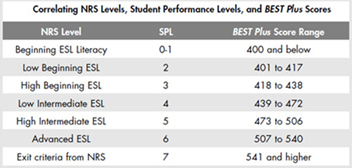Practical tools, activities, and resources
to guide instruction
Oral Proficiency - Descriptors
National Reporting System for Adult Education (NRS) Educational Functioning Levels
 In addition to the SPLs, adult ESL programs can use another set of descriptors to understand what language learners know and can do as they develop their English skills. The NRS ESL Educational Functioning Level descriptors (www.nrsweb.org) describe the performance characteristics of nonnative English speakers at six distinct levels and provide examples of the associated speaking and listening skills for each level. For example, students at NRS Low Beginning ESL can understand basic greetings, simple phrases, commands, and simple questions related to personal information spoken slowly and with repetition. Students at NRS Advanced ESL can understand and communicate in a variety of contexts related to daily life and work and show control of basic grammar but have difficulty using more complex structures.
In addition to the SPLs, adult ESL programs can use another set of descriptors to understand what language learners know and can do as they develop their English skills. The NRS ESL Educational Functioning Level descriptors (www.nrsweb.org) describe the performance characteristics of nonnative English speakers at six distinct levels and provide examples of the associated speaking and listening skills for each level. For example, students at NRS Low Beginning ESL can understand basic greetings, simple phrases, commands, and simple questions related to personal information spoken slowly and with repetition. Students at NRS Advanced ESL can understand and communicate in a variety of contexts related to daily life and work and show control of basic grammar but have difficulty using more complex structures.
Standardized assessments used for federal accountability reporting, such as BEST Plus, are aligned with the NRS levels. The two systems (SPLs and NRS levels) are distinct, but both describe the language proficiency of nonnative English speakers at various levels and can be used for various placement, diagnostic, reporting, and instructional purposes. The table below shows how NRS levels align with both SPLs and BEST Plus scale scores.

Source. Center for Applied Linguistics. (2005). BEST Plus Test Administrator Guide (Section III, p. 9). Washington, DC: Author.

